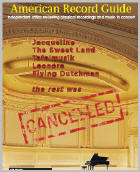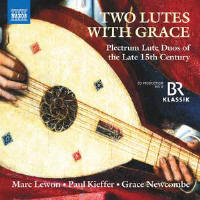Texte paru dans: / Appeared in: |
|
|
Outil de traduction ~ (Très approximatif) |
|
|
Reviewer: Bradley
Lehman All three of these musicians were students of the early-music school in Basel, inspired there by course work with Crawford Young (dedicatee of this disc). This recording documents the continued research by Young and themselves into the lute music of the late 15th Century. Most of this program is a reconstruction of the way a musician named Pietrobono (c1417-97) might have played with a partner. These are popular songs and dances. The lower-pitched instrument plays slow notes, covering the original tune or a lightly-elaborated version. The high instrument plays much faster ornamental notes in counterpoint, sometimes partly improvised. Both performers use a plectrum (pick) to pluck the strings. The player with the slow notes (Kieffer) sometimes plays two parts at once, using his fingernails along with his plectrum. The composers are Josquin Des Prez, Agricola, Tinctoris, Binchois, Dalza, Ghiselin, Roelkin, Bedyngham, Frye, and Van Ghizeghem, along with some anonymous contributors. Francesco Spinacino developed and published some of these arrangements in 1507. Marc Lewon is almost too good with his evenness of tone and volume—I'd welcome a bumpier ride to have it sound less carefully prepared. His highest notes are sometimes a little bit flat, introducing brief flaws that help sustain the interest in his torrents of notes. Kieffer is reliable with the easier role. As this ought to be, it's two guys getting together to jam and to have fun. They frankly admit that the last two pieces in the album are their own arrangements. These sound the most spontaneous and elaborate, partly because Kieffer gets more opportunity to ornament his low part.
| |
|
|
|
|
Cliquez l'un ou l'autre
bouton pour découvrir bien d'autres critiques de CD |
|




